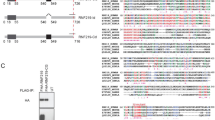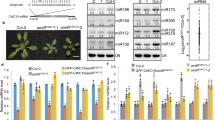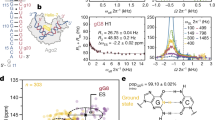Abstract
miRNA-mediated repression in animals is dependent on the GW182 protein family. GW182 proteins are recruited to the miRNA repression complex through direct interaction with Argonaute proteins, and they function downstream to repress target mRNA. Here we demonstrate that in human and Drosophila melanogaster cells, the critical repressive features of both the N-terminal and C-terminal effector domains of GW182 proteins are Gly/Ser/Thr-Trp (G/S/TW) or Trp-Gly/Ser/Thr (WG/S/T) motifs. These motifs, which are dispersed across both domains and act in an additive manner, function by recruiting components of the CCR4–NOT deadenylation complex. A heterologous yeast polypeptide with engineered WG/S/T motifs acquired the ability to repress tethered mRNA and to interact with the CCR4–NOT complex. These results identify previously unknown effector motifs functioning as important mediators of miRNA-induced silencing in both species, and they reveal that recruitment of the CCR4–NOT complex by tryptophan-containing motifs acts downstream of GW182 to repress mRNAs, including inhibiting translation independently of deadenylation.
This is a preview of subscription content, access via your institution
Access options
Subscribe to this journal
Receive 12 print issues and online access
$209.00 per year
only $17.42 per issue
Buy this article
- Purchase on SpringerLink
- Instant access to full article PDF
Prices may be subject to local taxes which are calculated during checkout






Similar content being viewed by others
References
Bartel, D.P. MicroRNAs: target recognition and regulatory functions. Cell 136, 215–233 (2009).
Huntzinger, E. & Izaurralde, E. Gene silencing by microRNAs: contributions of translational repression and mRNA decay. Nat. Rev. Genet. 12, 99–110 (2011).
Fabian, M.R., Sonenberg, N. & Filipowicz, W. Regulation of mRNA translation and stability by microRNAs. Annu. Rev. Biochem. 79, 351–379 (2010).
Djuranovic, S., Nahvi, A. & Green, R. A parsimonious model for gene regulation by miRNAs. Science 331, 550–553 (2011).
Chekulaeva, M., Filipowicz, W. & Parker, R. Multiple independent domains of dGW182 function in miRNA-mediated repression in Drosophila. RNA 15, 794–803 (2009).
Eulalio, A. et al. The RRM domain in GW182 proteins contributes to miRNA-mediated gene silencing. Nucleic Acids Res. 37, 2974–2983 (2009).
Zekri, L., Huntzinger, E., Heimstadt, S. & Izaurralde, E. The silencing domain of GW182 interacts with PABPC1 to promote translational repression and degradation of miRNA targets and is required for target release. Mol. Cell. Biol. 23, 6220–6231 (2009).
Huntzinger, E., Braun, J.E., Heimstadt, S., Zekri, L. & Izaurralde, E. Two PABPC1-binding sites in GW182 proteins promote miRNA-mediated gene silencing. EMBO J. 29, 4146–4160 (2010).
Zipprich, J.T., Bhattacharyya, S., Mathys, H. & Filipowicz, W. Importance of the C-terminal domain of the human GW182 protein TNRC6C for translational repression. RNA 15, 781–793 (2009).
Lazzaretti, D., Tournier, I. & Izaurralde, E. The C-terminal domains of human TNRC6A, TNRC6B, and TNRC6C silence bound transcripts independently of Argonaute proteins. RNA 15, 1059–1066 (2009).
Baillat, D. & Shiekhattar, R. Functional dissection of the human TNRC6 (GW182-related) family of proteins. Mol. Cell. Biol. 29, 4144–4155 (2009).
Fabian, M.R. et al. Mammalian miRNA RISC recruits CAF1 and PABP to affect PABP-dependent deadenylation. Mol. Cell 35, 868–880 (2009).
Jinek, M., Fabian, M.R., Coyle, S.M., Sonenberg, N. & Doudna, J.A. Structural insights into the human GW182-PABC interaction in microRNA-mediated deadenylation. Nat. Struct. Mol. Biol. 17, 238–240 (2010).
Behm-Ansmant, I. et al. mRNA degradation by miRNAs and GW182 requires both CCR4:NOT deadenylase and DCP1:DCP2 decapping complexes. Genes Dev. 20, 1885–1898 (2006).
Chen, C.Y., Zheng, D., Xia, Z. & Shyu, A.B. Ago-TNRC6 triggers microRNA-mediated decay by promoting two deadenylation steps. Nat. Struct. Mol. Biol. 16, 1160–1166 (2009).
Piao, X., Zhang, X., Wu, L. & Belasco, J.G. CCR4-NOT deadenylates mRNA associated with RNA-induced silencing complexes in human cells. Mol. Cell. Biol. 30, 1486–1494 (2010).
Chekulaeva, M., Parker, R. & Filipowicz, W. The GW/WG repeats of Drosophila GW182 function as effector motifs for miRNA-mediated repression. Nucleic Acids Res. 38, 6673–6683 (2010).
Yao, B. et al. Divergent GW182 functional domains in the regulation of translational silencing. Nucleic Acids Res. 39, 2534–2547 (2011).
Ezzeddine, N. et al. Human TOB, an antiproliferative transcription factor, is a poly(A)-binding protein-dependent positive regulator of cytoplasmic mRNA deadenylation. Mol. Cell. Biol. 27, 7791–7801 (2007).
Siddiqui, N. et al. Poly(A) nuclease interacts with the C-terminal domain of polyadenylate-binding protein domain from poly(A)-binding protein. J. Biol. Chem. 282, 25067–25075 (2007).
Mittag, T. et al. Structure/function implications in a dynamic complex of the intrinsically disordered Sic1 with the Cdc4 subunit of an SCF ubiquitin ligase. Structure 18, 494–506 (2010).
Eulalio, A., Helms, S., Fritzsch, C., Fauser, M. & Izaurralde, E. A C-terminal silencing domain in GW182 is essential for miRNA function. RNA 15, 1067–1077 (2009).
Höck, J. et al. Proteomic and functional analysis of Argonaute-containing mRNA-protein complexes in human cells. EMBO Rep. 8, 1052–1060 (2007).
Mayr, C., Hemann, M.T. & Bartel, D.P. Disrupting the pairing between let-7 and Hmga2 enhances oncogenic transformation. Science 315, 1576–1579 (2007).
Eulalio, A. et al. Deadenylation is a widespread effect of miRNA regulation. RNA 15, 21–32 (2009).
Collart, M.A. & Timmers, H.T. The eukaryotic Ccr4-not complex: a regulatory platform integrating mRNA metabolism with cellular signaling pathways? Prog. Nucleic Acid Res. Mol. Biol. 77, 289–322 (2004).
Fabian, M.R. et al. miRNA-mediated deadenylation is orchestrated by GW182 through two conserved motifs that interact with CCR4–NOT. Nat. Struct. Mol. Biol. 10.1038/nsmb.2149 (published online 7 Oct 2011).
Thickman, K.R., Swenson, M.C., Kabogo, J.M., Gryczynski, Z. & Kielkopf, C.L. Multiple U2AF65 binding sites within SF3b155: thermodynamic and spectroscopic characterization of protein-protein interactions among pre-mRNA splicing factors. J. Mol. Biol. 356, 664–683 (2006).
Cooke, A., Prigge, A. & Wickens, M. Translational repression by deadenylases. J. Biol. Chem. 285, 28506–28513 (2010).
Coller, J.M., Tucker, M., Sheth, U., Valencia-Sanchez, M.A. & Parker, R. The DEAD box helicase, Dhh1p, functions in mRNA decapping and interacts with both the decapping and deadenylase complexes. RNA 7, 1717–1727 (2001).
Temme, C. et al. Subunits of the Drosophila CCR4-NOT complex and their roles in mRNA deadenylation. RNA 16, 1356–1370 (2010).
Chu, C.Y. & Rana, T.M. Translation repression in human cells by microRNA-induced gene silencing requires RCK/p54. PLoS Biol. 4, e210 (2006).
Barbee, S.A. et al. Staufen- and FMRP-containing neuronal RNPs are structurally and functionally related to somatic P bodies. Neuron 52, 997–1009 (2006).
Eulalio, A. et al. Target-specific requirements for enhancers of decapping in miRNA-mediated gene silencing. Genes Dev. 21, 2558–2570 (2007).
Glavan, F., Behm-Ansmant, I., Izaurralde, E. & Conti, E. Structures of the PIN domains of SMG6 and SMG5 reveal a nuclease within the mRNA surveillance complex. EMBO J. 25, 5117–5125 (2006).
Weidenfeld, I. et al. Inducible expression of coding and inhibitory RNAs from retargetable genomic loci. Nucleic Acids Res. 37, e50 (2009).
Höck, J. et al. Proteomic and functional analysis of Argonaute-containing mRNA-protein complexes in human cells. EMBO Rep. 8, 1052–1060 (2007).
Mayr, C., Hemann, M.T. & Bartel, D.P. Disrupting the pairing between let-7 and Hmga2 enhances oncogenic transformation. Science 315, 1576–1579 (2007).
Chekulaeva, M., Filipowicz, W. & Parker, R. Multiple independent domains of dGW182 function in miRNA-mediated repression in Drosophila. RNA 15, 794–803 (2009).
Fabian, M.R. et al. Mammalian miRNA RISC recruits CAF1 and PABP to affect PABP-dependent deadenylation. Mol. Cell 35, 868–880 (2009).
Acknowledgements
We thank M. Collart (University of Geneva), A.-B. Shyu (University of Texas Medical School), H.T.M. Timmers (University of Utrecht), E. Izaurralde (Max Planck Institute for Developmental Biology), N. Sonenberg (McGill University), K. Schönig (Zentralinstitut für Seelische Gesundheit), J. Bethune (Friedrich Miescher Institute (FMI)), E. Wahle (Martin Luther University, Halle) and T. Yamamoto (University of Tokyo) for reagents; R. Sack, D. Klei, and the FMI Protein Analysis Facility for MS analysis; M. Tsai for help with the Y2H assay; and H. Gut, I. Loedige, J. Krol, J. Bethune, M. de la Mata, N. Thoma, F. Allain, E. Izaurralde and N. Sonenberg for stimulating discussions. M. Chekulaeva is the recipient of long-term postdoctoral fellowships from the Human Frontiers Science Program and Engelhorn Stiftung. J.A. is funded by the German National Academic Foundation. R.P. is supported by funds from the Howard Hughes Medical Institute. This work was supported by the European Community FP6 Program 'Sirocco'. The FMI is supported by the Novartis Research Foundation.
Author information
Authors and Affiliations
Contributions
M. Chekulaeva, H.M., J.T.Z., J.A., M. Colic, R.P. and W.F. designed the experiments. M. Chekulaeva, H.M., J.T.Z., J.A. and M. Colic conducted the experiments. M. Chekulaeva, H.M., R.P. and W.F. wrote the manuscript.
Corresponding author
Ethics declarations
Competing interests
The authors declare no competing financial interests.
Supplementary information
Supplementary Text and Figures
Supplementary Figures 1–8, Supplementary Table 1, Supplementary Results and Supplementary Methods (PDF 1224 kb)
Rights and permissions
About this article
Cite this article
Chekulaeva, M., Mathys, H., Zipprich, J. et al. miRNA repression involves GW182-mediated recruitment of CCR4–NOT through conserved W-containing motifs. Nat Struct Mol Biol 18, 1218–1226 (2011). https://doi.org/10.1038/nsmb.2166
Received:
Accepted:
Published:
Issue Date:
DOI: https://doi.org/10.1038/nsmb.2166
This article is cited by
-
AGO2 silences mobile transposons in the nucleus of quiescent cells
Nature Structural & Molecular Biology (2023)
-
Massively parallel identification of mRNA localization elements in primary cortical neurons
Nature Neuroscience (2023)
-
Control of immediate early gene expression by CPEB4-repressor complex-mediated mRNA degradation
Genome Biology (2022)
-
Ultrasensitive Ribo-seq reveals translational landscapes during mammalian oocyte-to-embryo transition and pre-implantation development
Nature Cell Biology (2022)
-
TASOR epigenetic repressor cooperates with a CNOT1 RNA degradation pathway to repress HIV
Nature Communications (2022)



